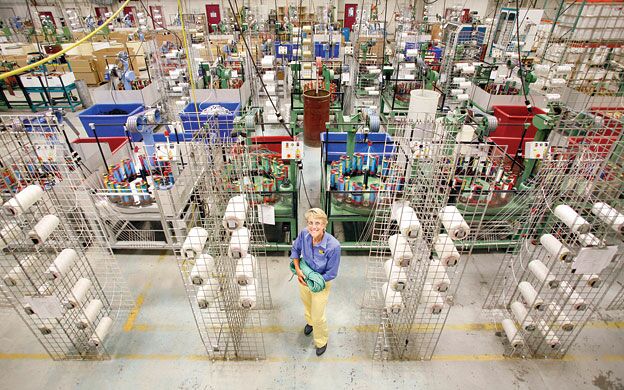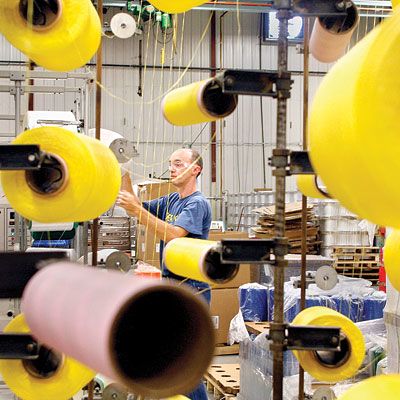Climbing success | Carolyn Brodsky, Sterling Rope
When you talk with Carolyn Brodsky, president and founder of Sterling Rope in Biddeford, the energy and passion she has for her work are obvious, especially when she starts talking about rope. It's almost irrelevant whether you understand the technical terms and numbers she's throwing out — her excitement is highly contagious.
You'll also notice that her knowledge of "all things rope" is matched — if not exceeded by — her strong business sense and commitment to the people who work for her.
"We've gotten where we are today by focusing on people and product, plain and simple," Brodsky says.
That combination and her entrepreneurial spirit were key to launching Sterling Rope, and have contributed to the company's steady growth from a "leap of faith" startup to one of the world's leading providers of rope for climbers, arborists and life-safety professionals. From 2009 to 2011, sales rose 65% and the company hired another dozen employees to keep pace. Brodsky's knowledge of the rope industry has earned her a seat on the board of directors of the Outdoor Industry Association, a trade group that promotes outdoor recreation in which climbing — and the importance of gear — have gained prominence.
In 1992, Brodsky, a racing sailor who had placed in the top five in a number of international races, owned and operated a marketing company that focused on the boating industry. With the arrival of high luxury taxes, Brodsky realized that industry's future was anything but bright. Pregnant at the time, she decided she wanted to combine her sales and marketing experience with her love of operations and manufacturing to start a company "to build something."
At the same time, she noticed extreme sports were taking off in popularity, so she and then-husband, Willie Crear, whose own marine industry experience had taught him a thing or two about rope, "mortgaged everything and put everything on credit cards" to start Sterling Rope in Marblehead, Mass. Crear had an idea to create a rope that used moisture-inhibiting materials common in the marine industry for its core. This had never been done and, when combined with dry-treated coating on the outside of the rope, became Sterling's key differentiator in the marketplace.
It wasn't long before Sterling outgrew its Massachusetts facility and discovered Maine hospitality. While searching for a town with a good school system, Brodsky and Crear found Scarborough and its economic development director, Harvey Rosenfeld, who was instrumental in welcoming the company by arranging meetings, helping them find land and even allowing Brodsky to use his office to interview prospective employees.
Although the company moved again, to Biddeford, Brodsky says those employees are the main reason behind Sterling's success, and she values them as such.
"The most important thing in business is to hire well. Great people equal great products equal great customers," she says. "It's like they say: Hire good people and get out of the way."
That theory was tested in late 2008, when the financial and housing crises hit and Sterling — like so many other businesses — found itself in rocky times.
"I was scared out of my mind," Brodsky says. "I can usually outsmart anything, but I couldn't outsmart this."
Reluctantly, Brodsky had to cut Sterling's work force in January 2009 and, in a meeting, asked employees for help weathering the storm and to help the company "not participate in the recession."
"One employee came to me after the meeting and said, 'I'll do whatever I can do to help.' That really shows that if you treat your employees well, they'll treat you well," she says.
The goal, Brodsky says, was simple: survive the downturn. Having made it through a drawn-out divorce that included a battle over the company (Brodsky eventually outbid Crear in a two-person auction to purchase it outright), Brodsky says she knew Sterling would make it through the hard times. She was right. Within three months, employees were once again working 40-hour weeks, and by June 2009 Sterling was hiring again.
Today, several of the world's leading climbers and arborists use Sterling's ropes, as do many fire departments across the country. The company also supplies rope to the military, a market Brodsky hopes to grow.
Ambassadors for Sterling
A testament to the quality and innovation of Sterling's products is that every New York City firefighter carries one of Sterling's FireTech ropes, with a Crosby hook on one end to allow them to quickly and safely exit a building through a window. Brodsky says Sterling's ropes have been to the top of Mt. Everest many times (they were featured in the IMAX film "Everest") and in 2001 were used to lift beams from the rubble at Ground Zero.
Experts in the field are an integral part of Sterling's product development and marketing. Most visible is the company's Sponsored Athletes Team. Started in the mid-'90s as the Product Design, Product Test Team, the roster consists of nearly 70 well-known climbers from around the world. Sterling sends them prototypes to test and products to use; they then can blog about their experiences. Sterling's website includes links to each climber's blog and to the particular Sterling products the climber has chosen to include in their toolkit. Sterling also sponsors USA Climbing, the governing body for professional climbing events.
Sterling pays two of the team's members: Chris Sharma, whom Brodsky describes as the world's most renowned climber, and Joe Kinder, a Maine College of Art graduate from New Hampshire. The relationship with Kinder is more than a sponsorship, Brodsky says. Kinder also provides graphic design services, including T-shirts and product tags, and produces videos — including several featuring Sharma — for Sterling.
Saying that "complacent companies fail," Brodsky never rests on accomplishments and past successes, and she won't allow Sterling to do so. She always solicits input from employees, customers and experts in their fields with whom Sterling has built relationships. Many great ideas — for products, streamlined production of those products, new markets to tap, etc. — have come from those sources, she says.
"We use and rely on our experts for a lot of our new product ideas; that's how we got into hardware," she says. "We've also created a structure that allows for employee growth. We actively invite ideas from our employees. If you look at the companies that are profitable, usually you'll find that everybody is engaged."
To register for a Sept. 20 reception honoring Carolyn Brodsky and the other Women to Watch, click here.
DOWNLOAD PDFs
Women to Watch 2012: Carolyn Brodsky
Read more
Research rainmaker | Blaine Grimes, Gulf of Maine Research Institute
Fixing health care | Lisa Letourneau, Maine Quality Counts
Driving performance | Melissa Smith, Wright Express Corp.
Profitable patterns | Pam Allen, Quince & Co.
Research rainmaker | Blaine Grimes, Gulf of Maine Research Institute
Fixing health care | Lisa Letourneau, Maine Quality Counts












Comments